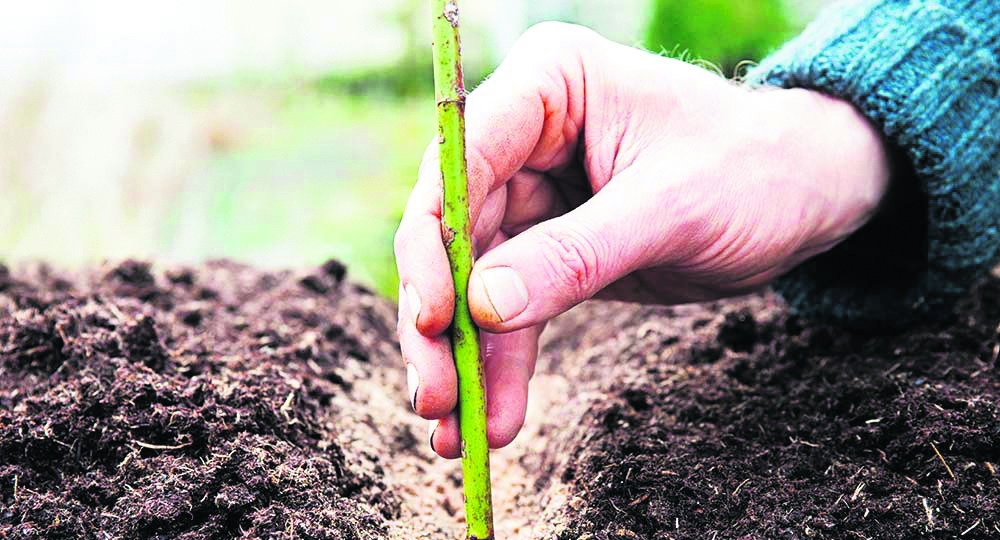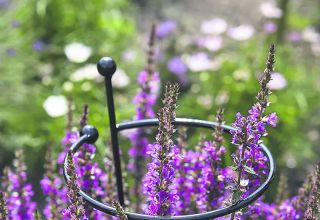These are the first few weeks of winter – so use the time carefully, let the last of the autumn run its course and target your energies to set things up for the months ahead. Tender plants will need protecting from frost, gales and freezing rains. Move plants into the greenhouse, or into a sheltered spot, but if you can’t, it is worth wrapping plants or pots. Winter can be a tough time for birds in terms of water and food, so keep supplies topped up.
Take hard wood cuttings
The window between now and the end of the year is the ideal time to take hardwood cuttings. As soon as the leaves have fallen, take cuttings at pencil length and pencil thickness. Make a clean cut immediately below a bud and a sloping cut above to tell top from bottom. Plunge to half their depth in compost or a trench in open ground if you don’t have a frame. Vines, cornus, willow, buddleia and fig will be rooted by spring and ready for potting by mid-summer. It’s a cheap and effective way of adding to your garden for next spring and too many gardeners worry it is too difficult. It isn’t – so give it a go!
Top of the heap
If you have the room, create a separate leaf heap rather than simply adding leaves to compost, as leaf mould is a luxury soil improver if you are for example growing lilies in pots. The fibrous nature of leaf mould retains moisture and enables free drainage, which means it also makes a fine mulch for woodland treasures such as trillium or wood anemone.
A leaf heap can easily be constructed using chicken wire and posts, or you can bag your leaves and put them in an out-of-the-way corner. Make sure you puncture the bags to prevent them from becoming anaerobic, as the bacteria that turn them to leaf mould need air to flourish. A leaf heap should take a year to rot down so empty now to make way for this year’s leaf fall.
Don’t worry too much about the leaves
Only collect leaves where absolutely necessary. Don’t leave them too long on the lawns or they will kill the grass underneath. Where they have fallen in the beds and have not drifted too deeply, leave the earthworms to pull them into their burrows and to rot on the surface. This is not laziness but necessary to keep the cycle replenished.
However, where leaves have drifted deeply or are smothering smaller plants or silver Mediterranean herbs and perennials, clear to keep the plants dry and airy. Sweeping leaves off paths and terraces is all you need to keep the garden looking cared for.

Its tulip planting time
Planting tulips in November won’t avoid the fungal disease tulip fire, despite what you may have read. This is generally the reason why tulips go into the ground later than daffodils and other spring bulbs. However, it is a good time to plant tulips, as they enjoy the cool, moist conditions that are associated with this time of year. Look for bulbs that have intact skins and don’t show signs of mould. Tulips should be planted two to three times the depth of the bulb.
Order bare-root plants
Save money by ordering bare-root plants, which are usually cheaper than the pot-grown equivalents, by mail order. They are only available in the dormant season, so you need to be quick. Try to plant them as soon as they arrive. Otherwise, give them a good soak in a bucket of water then roughly plant in a corner of the garden until you’re ready to put them in properly.
Container care
Remove saucers to avoid pots sitting in freezing water which can lead to rot.
Stand pots on clay feet to improve drainage. You can buy these from garden centres or save money by using broken tiles or similar to raise the base of the pots off the ground.
Protect vulnerable containers and plants from the worst weather by putting them in the warmest spot out of the wind against the house wall. You can also bubblewrap pots to protect against frost. If you hate the sight of this cover the wrap with a layer of hessian (perhaps saved from an old potato sack) and tie in place with string.
Time to really start thinking about the birds
The classic winter garden would not be complete without the appearance of winter birds, which flutter in to feed and breed from November onwards.
Providing food for these amazing creatures will not only help them survive the winter, but is also a great opportunity to see them up-close and can bring a great sense of satisfaction—a feeling that encouraging wildlife into the garden often creates.
There are a number of ways you can provide food for winter birds and this includes putting out bird feeders with seeds, suet balls or blocks and a source of water. A simple bird feeder with a seed mix will draw in plenty of flying wildlife, like sparrows, nuthatches and finches which greatly enjoy sunflower seeds.
Do you have much over-ripe fruit sitting in your fruit bowl at home? Scatter over-ripe apples, raisins and other fruits on the ground to attract thrushes and blackbirds.
It is important to remember that birds need fat as well as grains and fruit to survive throughout the winter. The most common method of providing this food group is with suet balls and suet cakes.
TLC for citrus trees
These should now be kept indoors or under glass in a light frost-free place. It is important to continue feeding and watering as necessary using a proprietary winter citrus feed. Only water when the soil is dry. How often this is will depend on where the plants are being over wintered. Pick up and dispose of any fallen leaves.

Yew know it’s right
Plan, order and plant new hedges. If you have had trouble with box blight, this is the moment to rip everything out and start again. A yew hedge is slow-ish growing but has all the neatness and glossiness of box and more, and is a great option should blight hit.
Plus
- This is an excellent time for taking stock of the things you’ll need for next year. On a warm day, scrub terracotta pots and let them dry in the sun.
- Prune red and white currants and gooseberries.
- Use netting to protect brassicas from pigeons.
- Stake any tall growing Brussels sprouts to prevent them being rocked by winter winds.
- Weed and dig over veg plots, adding in well-rotted muck or organic matter.
- Plant up hyacinths for an indoor winter flower display. If you want flowers for Christmas buy and plant up prepared bulbs.
- If you have a small garden, or are planting bulbs in pots, think about using smaller varieties of bulbs. Miniature daffodils (‘Tete-a-tete’ or ‘Topolino’), dwarf tulips and crocuses.
- If your tomato plants have been affected by blight, clear the plants and burn them, as adding them to the compost heap will not kill the spores.












